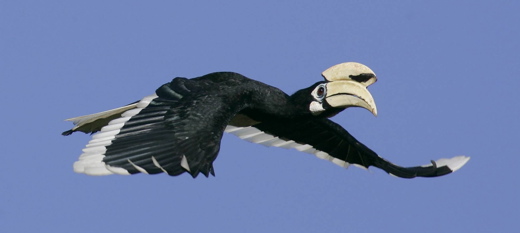A GPS device weighing less than 5% of the bird’s weight was attached to a male Oriental Pied Hornbill (Anthracoceros albirostris) during the period when his mate was brooding two chicks inside the artificial nesting box in Pulau Ubin, Singapore. The male hornbill was tracked for four days in April 2008.
During this period his flight pattern, flight speed, total area covered as well as his interaction with the environment was monitored. The date were transmitted to a computer and stored for future analysis.
All these information would be extremely useful when conservation strategies are being planned.
Image of the Oriental Pied Hornbill in flight by Chan Yoke Meng.
Reference:
Lai Hui Min, Marc Cremades, Giacomo Dell’omo, Robert Teo Chee Hin, Abdul Rashid b Abdul Jalil & Ng Soon Chye (2009). Global positioning system using satellite tracking of Oriental Pied Hornbill during the breeding season in Pulau Ubin, Singapore. Paper presented at the 5th Intn. Hornbill Conference, Singapore, March 2009.










7 Responses
certainly an interesting approach to scientific work and no doubt data collected would add value in understanding successful breeding patterns. just wondering is there any reason for 4 days-monitoring and not longer period (perhaps)?
further, is there any plan to share the breeding information in the form of scientific publication/magazine soon?
thks
I am sure the information will be published – in the proceedings of the conference. Will try get the author to respond…
Hi,
I would like to reply to the response.
Firstly, the 4 days period was short due to the consumption of the GPS and the weight allowance of batteries we can put on the bird. We used Bluetooth to download the data, and that consumes battery as well. For that first year, we chose to obtain fixations once every second to get a good coverage of where the bird goes because no-one can really say if it flies far or near. If we use one fixation every ten minutes, of course we can track for more days but the points will be more scattered and some data might be lost. This first study is to give us an idea, and now we know they do not range too far during the breeding season, future studies will last longer as we change the fixation interval.
And yes, we will be publishing at leat 2 papers with our findings, with 4 continuous years of breeding monitoring in the wild and in captivity, natural cavities and artificial nest.
Thank you very much for your comments!
Best regards,
Lai Huimin
Hi,
We are a group of student from River Valley High School, Singapore.
We are currently working on a project about birds.
We found some useful photos from your website and we would like to request for your permission to use those photos on our wikispaces.
Thank you.
Yours faithfully,
Yong Yi Li (4L)
River Valley High School
Singapore
“Image of the Oriental Pied Hornbill in flight by Chan Yoke Meng”
This one please. Thank you very much.
Hi, Have you published your movement pattern data for the OPH? Do you know anyone who has looked at gut-passage time for the OPH? Thanks, Soumya